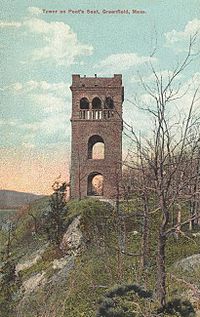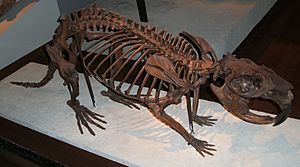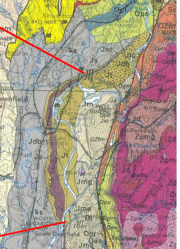Pocumtuck Range facts for kids
Quick facts for kids Pocumtuck Range |
|
|---|---|
| Metacomet Ridge | |

Poet's Seat Tower on Rocky Mountain, northern Pocumtuck Range. 1915 postcard.
|
|
| Highest point | |
| Peak | Pocumtuck Rock |
| Elevation | 846 ft (258 m) |
| Dimensions | |
| Length | 11 mi (18 km) east-west |
| Geography | |
| Country | United States |
| Geology | |
| Age of rock | Triassic and Jurassic |
| Type of rock | fault-block, igneous and sedimentary |
The Pocumtuck Range is a cool mountain area in Massachusetts. It's part of a bigger mountain chain called the Metacomet Ridge. You can find it in Franklin County, Massachusetts, between the Connecticut River and Deerfield River. People love to come here for hiking because of its amazing high cliffs, beautiful views, and special mini-ecosystems.
Contents
Exploring the Pocumtuck Range
This mountain range is about 11 miles (18 km) long. At its widest, it's about 1.75 miles (2.8 km) across. It includes a few different parts.
From south to north, you'll find:
- Sugarloaf Mountain: This mountain is in Deerfield, Massachusetts. It's famous for its historic road to the top. It also has steep cliffs that look out over the Connecticut River valley.
- Pocumtuck Ridge: This is the central, high part of the range. Its cliffs are about 2 miles (3 km) long. They rise 500 feet (150 m) above Interstate 91 and the Deerfield River Valley. The highest point here is Pocumtuck Rock, which is 846 feet (258 m) tall.
- Rocky Mountain (also called Greenfield Ridge): This part is in Greenfield, Massachusetts. It includes Sachem Head, a popular viewpoint. It also has Poet's Seat Tower, which is 492 feet (150 m) high. This tower overlooks Greenfield. The northern end is Canada Hill, which is 338 feet (103 m) tall.
The Deerfield River flows between Rocky Mountain and Pocumtuck Ridge. It then joins the Connecticut River. The Pocumtuck Range is entirely within Deerfield and Greenfield.
Why is it Called Pocumtuck?
The name Pocumtuck comes from a Native American tribe. This tribe used to live in the area a long time ago. They had a cool story about how the Pocumtuck Ridge and Sugarloaf Mountain were formed.
They believed a giant beaver lived in a huge lake. This lake covered the whole Connecticut River Valley. The beaver caused trouble, eating fish and even people. A powerful spirit named Hobomock came to help. He chased the beaver and killed it by jamming a stake into its head.
The Native Americans said: "The earth over the beaver's head we call Sugarloaf. His body [Pocumtuck Ridge] lies just to the north of it."
This story might have some truth to it! Scientists know that a huge lake, called Lake Hitchcock, existed here after the Ice Age. This was about 15,000 years ago. Also, a giant beaver species, Castoroides ohioensis, lived around that time. These beavers were as big as black bears and weighed up to 450 pounds (200 kg). They even had teeth the size of bananas!
Rocks and Special Plants
The Pocumtuck Range is made of a rock called Sugarloaf arkose. This is a strong sedimentary rock. In some places, it's covered by a thin layer of volcanic rock called trap rock. The arkose is easy to see on Sugarloaf Mountain. The trap rock is more visible on Rocky Mountain.
These rocks were formed between 190 and 210 million years ago. This was when North America started to split away from Africa and Eurasia. Over time, layers of rock formed from lava flows and erosion. Then, earthquakes tilted these layers. Now, you can see these tilted layers of rock today.
Unique Ecosystems
The Pocumtuck Range has special mini-ecosystems, called microclimates. These are unusual for the area.
- You can find Eastern red cedar trees on the dry cliff edges.
- In other areas, you'll see trees common in hardwood and oak-hickory forests.
- Eastern hemlock trees grow in narrow, damp ravines. These spots are cooler and have different plants.
- The rocky slopes are rich in nutrients. They support plants that love calcium, which are rare nearby.
The many cliffs are perfect homes for raptors (birds of prey). The range is also an important path for raptors migrating each season. You can find 37 different kinds of ferns here! This makes it one of the richest places for fern diversity in Massachusetts. The range also has many whorled pogonia plants. These are on a special watch list to protect them.
The Massachusetts Audubon Society says that the Rocky Mountain part of the range is "exceptionally rich" in bird species. This is especially true during migration. It's also an important place for birds to breed and spend the winter.
Fun Things to Do and Protecting the Land
There are many fun activities to do on the Pocumtuck Range. These include hiking, mountain biking, snowshoeing, backcountry skiing, hunting (in season), picnicking, and bird watching.
Much of the Pocumtuck Range is protected land. This includes state parks, town lands, and private land set aside for conservation. The Pocumtuck Ridge Trail is 20 miles (32 km) long. It starts on South Sugarloaf and goes all the way to Poet's Seat.
There are also many smaller trails. Sugarloaf Mountain is managed as the Mount Sugarloaf State Reservation. It has an observation tower and a road to the top that's open in season. Poet's Seat Tower and the park around it are managed by the City of Greenfield. The tower was built in 1912 and named after a local poet. You can visit the tower by walking a short trail or driving (in season).
The biggest threats to the Pocumtuck Range are new buildings and rock quarries. But the Massachusetts Department of Conservation and Recreation and local groups are working hard to protect this special area.





